Snow Types
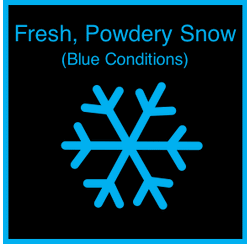
Blue Snow Conditions (Fresh, Powdery Snow, 0°C to -12°C)
Blue conditions are fresh powder. New snow: the natural snowflake structure is still intact. These are what we call perfect conditions. The trails are silky smooth, and it's difficult to make a snowball. Blue conditions are not so cold that the snow makes a squeaking noise when you step on it. Not too warm, not too cold. And not too humid either. Just right.
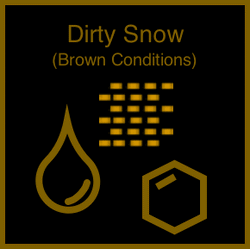
Brown Snow Conditions (Dirty Snow, Any Temperature)
Brown conditions are a quasi-condition. Think of brown conditions as a wrapper on yellow, red, violet and green conditions when the snow is dirty. Blue, orange and pink conditions are sometimes wrapped in brown conditions, but not frequently, as new snow is rarely dirty. Dirt tends to accumulate on top of the snowpack as it melts or is blown in on windy winter days.
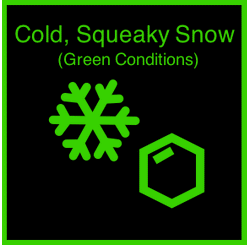
Green Snow Conditions (Cold, Squeaky Snow, -12°C to -30°C)
Green conditions are the coldest conditions. This snow will squeak when compressed. It can be new, old or man-made snow. Usually very dry. The harder the wax, the better it will be in these conditions for both skate and classic. High fluor waxes have trouble working in the low humidities usually found at these temperatures. These waxes are coloured green by all the brands I can think of.
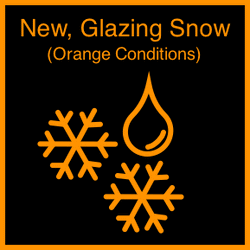
Orange Snow Conditions (New, Glazing Snow, +5°C to -5°C)
Orange snow conditions occur when freshly falling snow or new snow is humid enough to be 'packing snow.' This type of snow is perfect for making a snowman or a snowball fight! The natural snow crystal structure is still present - you can still pick up snow from the ground and still find relatively unbroken snowflakes. However, when this type of snow is skied over, its high humidity causes it to pack and glaze. This is a very tricky condition for waxing. On the one hand, snow crystals can still be sharp if there hasn't been heavy traffic on the trails, presenting you with a level of kinetic friction. But as the tracks get skied in, they tend to glaze, meaning kinetic friction is less of an issue. High humidity causes a suction component (wet friction) to always be a consideration in orange conditions.
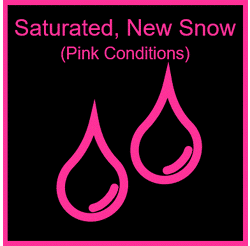
Pink Snow Conditions (Saturated, New Snow, +20°C to 0°C)
Pink conditions occur when fresh snow becomes thoroughly saturated with water. This happens at temperatures at and well above zero Celsius or in rare circumstances when the ground radiates heat up through the snowpack. The fresh snow is melting, turning into slush and hanging on to almost all its moisture as it melts. The snow is weighty, and sticks to tree branches as it falls. Pink conditions are the slowest conditions. It takes a lot of energy to force a ski through the high levels of suction friction.
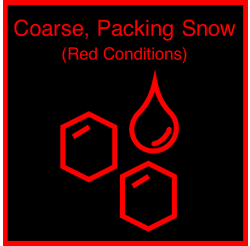
Red Snow Conditions (Coarse, Packing Snow, +5°C to -5°C)
Red conditions occur when old snow or artificial snow enters the transition temperature range around zero Celsius. High humidity differentiates red conditions from violet conditions - if there’s moisture in the snow, it’s red. If it’s dry, it’s violet. The track in red conditions tends to be corny, moist, and packs/glazes when skied over.
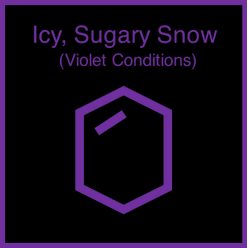
Violet Snow Conditions (Icy, Sugary Snow, 0°C to -15°C)
Violet conditions consists of icy, old snow that breaks up into sugary or corny snow. This type of snow is old, transformed and quite abrasive. Usually, this type of snow has lower humidity. Often artificial snow falls into this category. These are the fastest of all conditions. Usually, waxes for this temperature are coloured violet by most wax brands.
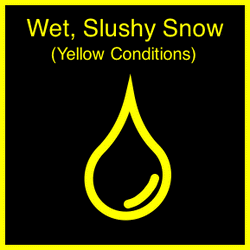
Yellow Snow Conditions (Wet, Slushy, Old Snow, +20°C to 0°C)
Yellow conditions occur when old snow is thoroughly saturated with water. It's slushy; it's wet; it's warm; it's old and usually coarse-grained and dirty. The temperature range for these conditions is 0C to... the warmest it can be with snow on the ground! 'Yellow' snow is heavily transformed. It has been through a melt/freeze cycle or two and has become corny or coarse-grained. Because the snow transformed, it tends to drain better than 'Pink' snow since the space between the individual ice crystals allows water to drain away. You're still dealing with a lot of water either way, so your main waxing consideration will be to get rid of water from the ski base! The big difference between pink and yellow conditions is the amount of dirt deposited on top of the snowpack. Choosing a wax with compounds to limit the effects of dirt is also key when waxing for yellow conditions.
